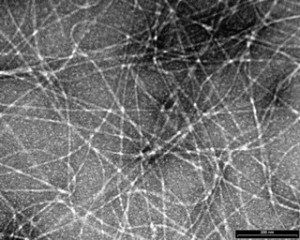

Because most HIV-1 infections are a consequence of genital exposure to semen of virus-infected men, seminal fluid was screened for peptides or proteins that enhance viral infectivity. Peptides (34 – 40 amino acids in length) derived from prostatic acidic phosphates, a common protein found in semen, were found to dramatically enhance HIV-1 infection of cultured cells. These peptide fragments form amyloid fibrils which bind both virions and cells, thereby promoting virus attachment and stimulating infectivity. The prostatic amyloid fibrils, called SEVI, are found at high levels in semen, which also stimulates HIV infection. SEVI is believed to play an important role in sexual transmission of HIV. Inhibitors of the stimulatory effect of SEVI on HIV infection, such as surfen, may have therapeutic value.
Xenotropic murine leukemia virus-related virus (XMRV) has been detected in prostate cancer tissues and is therefore a candidate tumor virus. XMRV, which has also been implicated in chronic fatigue syndrome, was first isolated from prostate tissue. Therefore it made perfect sense to determine whether SEVI, which originates from the prostate gland, enhances XMRV infection.
The observation that SEVI enhances XMRV infection is consistent with the possibility that the virus is sexually transmitted. Men with a history of prostatitis or sexually transmitted infections appear to have a higher risk of acquiring prostate cancer. However, the effect of a prostate-derived peptide on XMRV infection might be coincidental: the amyloid fibrils could stimulate infection by other viruses, as noted by the virologists who discovered SEVI:
…the capability to promote the interaction between virions and the cell surface is independent of the viral Env glycoprotein and hence not restricted to retroviruses. Thus, further studies on the role of amyloids in the transmission and pathogenesis of enveloped viruses are highly warranted.
About 30 human diseases, including Alzheimer’s, are associated with deposits of amyloid. Bacterial and fungal infections can also lead to formation of amyloid fibrils – which could explain why sexually transmitted diseases increase the likelihood of acquiring prostate cancer. The ability of these fibrils to enhance infection with different viruses should be examined. It’s possible that different amyloid fibrils are a new general risk factor for certain viral infections.
Hong, S., Klein, E., Das Gupta, J., Hanke, K., Weight, C., Nguyen, C., Gaughan, C., Kim, K., Bannert, N., Kirchhoff, F., Munch, J., & Silverman, R. (2009). Fibrils of Prostatic Acid Phosphatase Fragments Boost Infections with XMRV (Xenotropic Murine Leukemia Virus-Related Virus), a Human Retrovirus Associated with Prostate Cancer Journal of Virology, 83 (14), 6995-7003 DOI: 10.1128/JVI.00268-09

Is it possible that XMRV can also be transferred through the blood as well as is HIV?
Pingback: Tweets that mention XMRV infection is enhanced by prostatic protein fragments -- Topsy.com
Pingback: uberVU - social comments
Vincent, I feel like I am hearing a lot about XMRV all of a sudden. Is that because you're focusing on it in the blog, or because there is an unusual amount of new findings about it recently? Thanks!
Yes, it's possible, since XMRV is present in blood. How the virus is
transmitted depends upon where else it is present in infected people.
For example, measles virus is found in the blood, but it is
transmitted by the respiratory route. If XMRV is not found in
secretions of any type, then two modes of spread are through blood
products or sexual transmission.
XMRV is a newly discovered human virus that has been associated with
two serious diseases, prostate cancer and CFS. So it's a great
opportunity to track a virus from the start: from discovery to
characterization to understanding disease etiology. We professors call
it a 'teaching opportunity'. Because it's new, many labs are beginning
to work on the virus, hence more and more work will be published.
It is my understanding that not much is known about viral reservoirs at least in XMRV. How might that affect whether tests, such as blood tests, are positive or negative? Or would it?
According to this publication: http://cme.medscape.com/viewarticle/715443?src=… ,
Aciclovir decreases the 'viral load' in HIV. The question is, would it also possibly do that in XMRV and would valacyclovir have the same properties?
According to this publication: http://cme.medscape.com/viewarticle/715443?src=… ,
Aciclovir decreases the 'viral load' in HIV. The question is, would it also possibly do that in XMRV and would valacyclovir have the same properties?